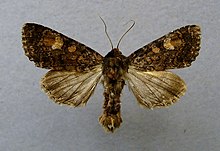Black and white tussock owl
| Black and white tussock owl | ||||||||||||
|---|---|---|---|---|---|---|---|---|---|---|---|---|

Black and white tufted owl ( Apamea rubrirena ) |
||||||||||||
| Systematics | ||||||||||||
|
||||||||||||
| Scientific name | ||||||||||||
| Apamea rubrirena | ||||||||||||
| ( Treitschke , 1825) |
The black and white grass tufted owl ( Apamea rubrirena ), also called black and brown hard grass owl, is a butterfly ( moth ) from the family of the owl butterflies (Noctuidae).
features
butterfly
The wingspan of the moth is 40 to 51 millimeters. The black and white tufted owl is a species that is extraordinarily variable in terms of color, wing shape and size. The basic color of the forewings varies from pale orange to reddish brown to blackish brown. Primarily climatic or geological influences are responsible for the color design. Kidney and ring blemishes are large and often distinctly light yellow or reddish in color. Cross lines and wavy lines are indistinct or whitish. The hind wings are monochrome, light gray-brown, with the veins clearly protruding.
Caterpillar
The caterpillars are glassy, dirty white in color, have black pointy warts and a shimmering dorsal vessel ( heart tube of the arthropods ). The head and pronotum are colored black-brown.
distribution and habitat
The distribution of the species extends from northern and western Europe and further east through Russia and Asia to Japan and Korea . Other areas of occurrence are the Kuril Islands , the Aleutian Islands and Alaska . In the Alps it rises to around 2,300 meters. The black and white grass tufted owl can be found in deciduous, mixed and coniferous forests.
Way of life
The moths are nocturnal and occasionally visit different flowers in the evening, such as:
- Blackberries ( rubus )
- Cabbage thistle ( Cirsium oleraceum )
- Pigeon goiter ( Silene vulgaris ) and
- Devil's Claws ( Phyteuöma ).
They appear at night on artificial light sources , and more rarely on bait, and fly in one generation from June to August, and in some areas even in September. The caterpillars mainly live from August, overwinter and pupate in May or June of the following year. They stay in a cave in the ground in the root neck area of tufts of grass and feed on the stalks of different grasses, such as forest fescue ( Festuca altissima ) and forest riding grass ( Calamagrostis arundinacea ).
Danger
The black and white grass tufted owl can only be found in some regions of Germany in varying frequencies, but is not classified as endangered on the Red List of Endangered Species .
swell
Individual evidence
- ^ A b Alberto Zilli, László Ronkay, Michael Fibiger: Apameini . In: WG Tremewan (Ed.): Noctuidae Europaeae . 1st edition. tape 8 . Entomological Press, Sorø 2005, ISBN 87-89430-09-3 (English).
- ^ A b Walter Forster , Theodor A. Wohlfahrt : The butterflies of Central Europe. Volume 4: Owls. (Noctuidae). Franckh'sche Verlagshandlung, Stuttgart 1971, ISBN 3-440-03752-5 .
- ^ A b Arno Bergmann: The large butterflies of Central Germany. Volume 4/2: Owls. Distribution, forms and communities. Urania-Verlag, Jena 1954, DNB 450378381 .
- ^ Günter Ebert (Ed.): The butterflies of Baden-Württemberg . 1st edition. tape 6 . Moth IV. Noctuidae 2nd part. Ulmer, Stuttgart (Hohenheim) 1997, ISBN 3-8001-3482-9 .
- ↑ Federal Agency for Nature Conservation (Ed.): Red List of Endangered Animals in Germany . Landwirtschaftsverlag, Münster 1998, ISBN 3-89624-110-9 .
literature
- Alberto Zilli, László Ronkay, Michael Fibiger: Apameini . In: WG Tremewan (Ed.): Noctuidae Europaeae . 1st edition. tape 8 . Entomological Press, Sorø 2005, ISBN 87-89430-09-3 (English).
- Günter Ebert (Ed.): The butterflies of Baden-Württemberg . 1st edition. tape 6 . Moth IV. Noctuidae 2nd part. Ulmer, Stuttgart (Hohenheim) 1997, ISBN 3-8001-3482-9 .
Web links
- www.lepiforum.de Photos
- www.nic.funet.fi occurrence
- www.schmetterlinge-deutschlands.de Endangerment
- Apamea rubrirena in Fauna Europaea
